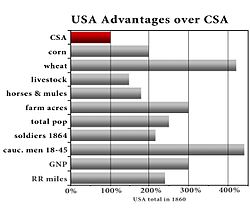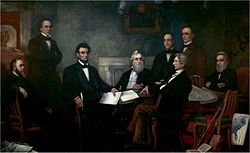Union (American Civil War)
During the American Civil War, the Union meant the federal government of the United States, which was supported by the twenty free states and five border states. It was opposed by 11 Southern slave states. The Union states included the Western states of California, Oregon, and (after 1864) Nevada. They also included states then called the "Old Northwest" and now usually thought to be part of the Midwest. However, the Union has been also often called "the North", both then and now.[1] The Union states were mostly richer and more industrialized.
The Union states were:
Union (American Civil War) Media
"Hail, Columbia", the former (unofficial) national anthem of the United States of America, preceded by four ruffles and flourishes as would be played for the Vice President of the United States, performed by the United States Navy Band Ceremonial Band. Featured on the 1990s album Music For Honors and Ceremonies.
Instrumental music without lyrics: Rufst du, mein Vaterland also known as God Save the King, Íslands minni, Kongesangen and Oben am jungen Rhein (1938)
The division of Union and Confederate states during the American Civil War, which lasted from 1861 to 1865
The United States had large advantages in men and resources at the start of the war, and the ratio grew steadily in favor of the United States. In the chart, "cauc men" means white men (Caucasian).
Lincoln met with his Cabinet for the first reading of the Emancipation Proclamation draft on July 22, 1862.
Union soldiers on the Mason's Island, later renamed Theodore Roosevelt Island, on the Potomac River in 1861
Union soldiers Marye's Heights during the Second Battle of Fredericksburg in May 1863
Related pages
References
- ↑ "Avalon Project - The Inaugural Addresses of the Presidents". avalon.law.yale.edu. Retrieved 7 June 2010.
- Current, Richard N. (1994). Lincoln's Loyalists: Union Soldiers from the Confederacy. Oxford, England: Oxford University Press. ISBN 0-19-508465-9.
- Mackey, Robert R. (2004). The UnCivil War: Irregular Warfare in the Upper South. Norman, OK: University of Oklahoma Press. ISBN 0-8061-3624-3.







